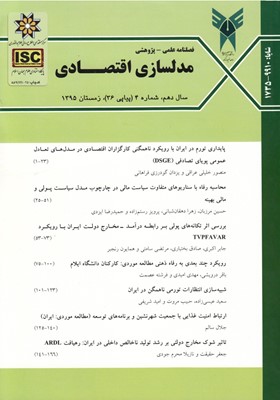طراحی یک مدل دینامیک برای صنعت گردشگری در ایران با استفاده از رویکرد پویایی شناسی سیستم برای افق ایران 1404
محورهای موضوعی : اقتصاد کار و جمعیتعلی حسین صمدی 1 , علی نقی مصلح شیرازی 2 , آناهیتا روحی 3
1 - استادیار دانشگاه شیراز
2 - دانشیار دانشگاه شیراز
3 - کارشناسی ارشد دانشگاه شیراز
کلید واژه:
چکیده مقاله :
در این مطالعه یک مدل دینامیکی برای گردشگری ایران طراحی و با شبیهسازی آن طی سالهای1404-1386 به پیشبینی وضعیت این صنعت درآینده و بررسی شرایط لازم برای دستیابی به اهداف آن در سال1404پرداختهایم. نتایج حاصل از شبیهسازی مدل پایه با استفاده از نرمافزارVensim نشان میدهد که با ادامه ی وضعیت کنونی، در سال 1404 شاهد ورود حدود پنجونیم میلیون گردشگر خواهیم بود؛ این درحالی است که ورود بیست میلیون گردشگر خارجی یکی از اهداف صنعت گردشگری در آن سال است. بنابراین، به منظور بررسی شرایط لازم جهت دستیابی به این هدف، پیشنوشتههای متفاوتی طراحی و شبیهسازی شده است. نتایج حاصل از شبیهسازی پیشنوشتههای مختلف نشان میدهد که لازم است برای رسیدن به این هدف علاوه بر هماهنگی در عملکرد زیرسیستم هابه طور همزمان، تلاشهایی در زمینهی بهبود اثرگذاری تبلیغات بر جذب گردشگران، آموزش هرچه سریعتر کارکنان این صنعت و افزایش ظرفیتهای موجود صورت گیرد.
By using SD approach in this study, we have developed a dynamic model for the future of Iranian tourism industry and simulated it during 2007-2025. Besides, to understand the dynamics involved, the purpose of this study is to forecast the industry’s future and to observe the requirements to get the objectives in the horizon of 2025. The model designed includes three main sub-systems, namely; the demand for tourism, tourism activities, and tourism capacity building. By Vensim software, the simulation results of the model explain that, if the current rates of capacity development, advertisements, and human resource development activities continue in this industry, then, we will absorb only a demand about 5.5 million tourists in 2025, that is, well below the standard of 20 million tourists per year in the horizon of 2025. The results of the simulation reveal that, to reach the tourism objectives planned, firstly, 3 sub-systems mentioned above must be coordinated and worked well together, and secondly, some prompt actions should be planned to boost the effectiveness of advertisement, the training of workforce in this regard.


